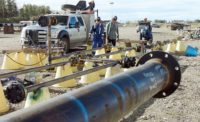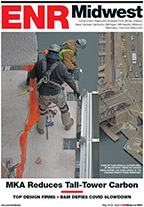If a rising tide lifts all boats, the resurgent manufacturing sector has several Midwest contractors riding a welcome wave of activity not seen in years. Among those experiencing the greatest lift is Detroit-based Walbridge, ENR Midwest’s Contractor of the Year, which reaped $633 million in regional revenue in 2014—a 28% increase over the prior year.
Related Links:
Design Firm of the Year
Contractor of the Year 2014
As might be expected for the world’s fourth-largest contractor for automotive facilities, the return of vehicle and component manufacturing to U.S. shores fueled a large part of that growth, including a current design-build contract with Troy, Mich.-based Gallagher-Kaiser Corp. to execute a 1.3-million-sq-ft paint shop at General Motors’ Flint Assembly complex, part of a $600-million upgrade program at the automaker’s facility.
A strong presence in other markets is paying off for Walbridge as well, from construction management for Marathon Petroleum’s new administration facility, a distinctive boomerang-shaped building rising on a 17-acre site in Detroit, to the recently awarded fast-track expansion of Bell’s Brewery’s Comstock Campus in Kalamazoo, Mich. Also in the mix are Michigan State University’s 500,000-sq-ft State Police Post Redevelopment in East Lansing, another recently awarded project, and the historic renovation of the David Whitney Building in downtown Detroit, a project completed last fall.
Nevertheless, Rick Haller, president and chief operating officer of the firm, recognizes that any discussion about the fortunes of the Midwest’s construction industry typically begins and ends with manufacturing. “The economy is good, and it’s about time in this part of the country,” he says. “There’s a lot of pent-up demand in the manufacturing and industrial sectors, and we’ve been able to capitalize by putting the right experience where it’s needed.
The ability to deftly deploy required resources across so many diverse sectors is no accident. Though Walbridge’s organizational structure consists of distinct, vertical operating groups for industrial facilities, buildings and process work, an overlying matrix implemented by Haller 15 years ago fosters cross-unit collaboration, providing the staffing, resources and flexibility essential for managing complex construction projects.
“Our managers are laser-focused on what’s happening in their respective sectors—what’s in the pipeline, what delivery method a client prefers and so forth,” Haller says. “At the same time, they’re also up on what’s happening in the other areas. If a particular expertise is available in another unit or another office, they know how to access it.”
The Marathon Petroleum administrative complex, for instance, brought diverse resources to bear during planning. “They do a lot of process work, so it’s only natural that our process experts be closely involved with the buildings experts,” says Haller “Similarly, a lot of institutional owners look at capabilities and experience for their qualifications-based selections. Usually whatever they’re looking for, we can provide it.”
Those capabilities successfully converged on the new Munger Graduate Residence Hall at University of Michigan in Ann Arbor. As construction manager at-risk for the new eight-story, 370,000-sq-ft facility, Walbridge recognized the opportunity to prefabricate 730 modular bathrooms off site, then orchestrate staged delivery of completed units to the site as floors were completed.
“We had production set up assembly-line style,” says Mike Haller Jr., superintendent-union for the bathroom work. “The trades picked it up in a matter of weeks, and we underwent full inspection of each unit before it was shipped to the site. Once there, all that was required was installation and a final sign-off by university inspectors.”
The younger Haller estimates that material savings alone from offsite prefabrication could have yielded a number of bathrooms for an additional floor.
The approach also resulted in scheduling and logistical benefits, says Walbridge senior project manager Mark Corey. “Not only were we able to execute the bathrooms concurrent with the precast work, but the jobsite was much less cluttered with materials and workers,” he says. “Use of BIM allowed us to determine the best locations for transporting and staging completed modules and avoid interfering with work under way on upper floors.”
Minimizing jobsite congestion for reasons of project efficiency meshes well with another Walbridge priority: safety. In 2010, the firm was the inaugural recipient of the Michigan Occupational Safety and Health Administration’s Voluntary Protection Program for Construction Star Award. It currently boasts more than 12 million hours worked without a lost-time injury.
“In my 24 years with Walbridge, there’s never been a doubt of its commitment to safety, from top management to field employees,” says Mark LaClair, the firm’s assistant vice president for safety.







Post a comment to this article
Report Abusive Comment